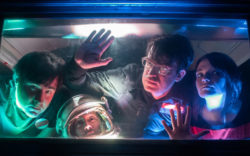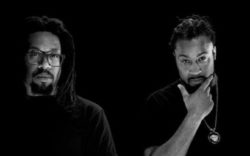As the driving force behind New Zealand psychedelic rock band Unknown Mortal Orchestra, frontman Ruban Nielson likes to see how far he can push things. During a recent tour, Nielson started jumping into the audience with his guitar every night and found himself going a little farther each time. At first, he was limited by the length of his guitar cable, but eventually, he switched to a wireless setup, allowing his antics to reach balcony-level seating.
“That’s an extreme example,” he says, “but it happens on every level, you know? When every aspect of a live performance is like that, people might come to our show and be surprised by how many goodies we’ve added that weren’t on the record.”
Since debuting with a self-titled album in 2011, UMO has embodied the experimental, boundary-pushing spirit of psychedelia rather than adopting the more typical effects-heavy aesthetic. After earning early critical praise as a lo-fi indie group, UMO’s glossy 2015 album, Multi-Love, catapulted it into the upper tier of touring psych bands alongside the likes of Mac DeMarco and Tame Impala.
“Things really went into overdrive after Multi-Love came out,” Nielson says. “We became the second-biggest band in the genre behind Tame Impala, I guess. That’s really flattering in a lot of ways, but it would be cool if people realized the bands aren’t particularly similar… Tame Impala is this pop extravaganza, and we’re like a grubby rock band. We’re a pretty rag-tag bunch, and my records are much less ambitious in a lot of ways. There’s a lot of bombast in that music I’m always turning away from.”
UMO’s fourth album, Sex & Food, dropped in April, and the band is in the middle of a grueling tour schedule, including a show at the Georgia Theatre on Monday, July 9.
The “band” is mostly Nielson’s solo project: He’s the singer, guitarist, primary songwriter and producer. On Sex & Food, he kept the mix understated and restrained, with a subtle undercurrent of funk throughout. Nielson says he drew inspiration from the tones and textures in David Bowie’s Station to Station but also strived to achieve a more modern, “widescreen” sound à la Kanye West’s Yeezus.
“What I think I’m trying to do is create old-fashioned textures and put them in a modern sound field,” he says. Even so, he didn’t get too carried away with the high-fidelity treatment. “The music itself and the way it makes you feel really important, and the sonics can actually get in the way of that,” he says.
UMO is a touring act, first and foremost. Nielsen measures success not in commercial terms, but by how well the members of the band gel musically and personally, and to what extent that togetherness comes across onstage. He wants UMO to take real risks every night, and that means playing without guardrails.
“I think people would be really shocked by how little they’re really seeing when they go to a concert these days, how bands are putting on a backing track and basically pretending to play over top of it,” he says. “I like electronics and stuff too, but a lot of the time, bands use those backing tracks as a train track they can’t deviate from, which I guess makes it easier for some people to play music. For me, I have to feel like if we make a mistake, the whole song will be ruined. I need that kind of pressure.”
As a byproduct of all that risky business, the band’s sets tend to evolve over the course of a tour. The group will learn the songs during rehearsal and gradually “wear them in,” as Nielson puts it, embracing happy accidents and improvisation along the way. It’s just another example of his tendency to keep pushing everything as far as it will go.
“If it feels good and works well, it becomes the new way you do it every time,” he says. “The goal is to take each song to its peak—to where it can’t be improved any further. By the time you’ve passed that point, it’s time to make a new album.”
Like what you just read? Support Flagpole by making a donation today. Every dollar you give helps fund our ongoing mission to provide Athens with quality, independent journalism.










